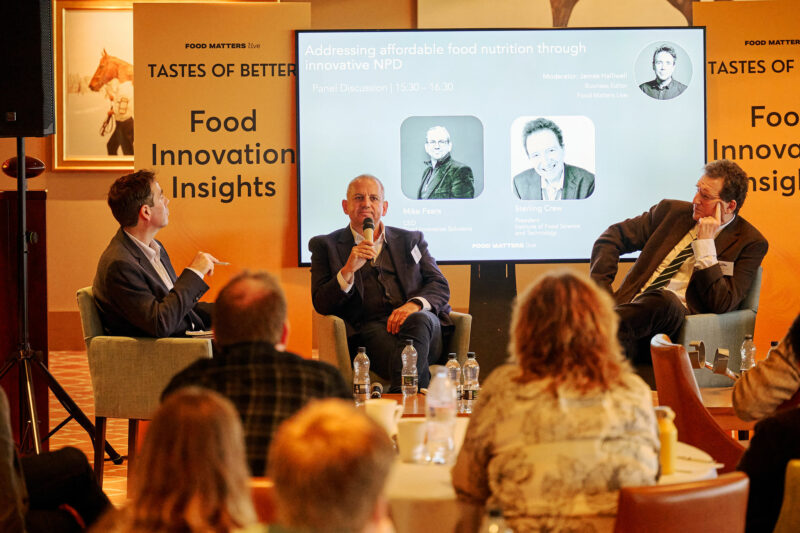The big issues facing the reformulation industry

Tastes of Better introduced a series of insight sessions at Ascot, featuring an expert roster of industry panellists to offer their thoughts and experience. Here is what they identified as the big issues facing the reformulation industry in the next 12 months.
Health by stealth
Despite consistently ranking as a key purchasing decision for consumers, a perception that HFSS reformulated foods also means a compromise when it comes to taste persists, especially in the confectionary or snack categories where comfort, indulgence and taste are the main selling points. In a suggestion that echoed throughout the two days, Saquib Ramday, head of category development at Tate and Lyle, suggested silent reformulation, or gradually improving the nutritional profile of food products without shouting about it to consumers, was the way forward.
Other industry insiders also discussed successful “health by stealth” initiatives, including Mike Faers, CEO of Food Innovation Solutions, who highlighted a covert operation to reduce salt in McDonald’s nuggets. He argued the industry has a moral responsibility to reformulate for health, so long as taste isn’t a casualty, saying: “It’s incumbent on us to see how low we can go without harming taste.” And Edward Bergen, senior analyst at FutureBridge, asked: “Do you really want to tell them you’ve reformulated if the product delivers on taste and price?”.
Proactive vs reactive
Is the food industry a passive servant to consumer demand? Or should it seek to shape consumer behaviours for the good of their health and the planet? Julie Owst, head of sustainability at Bidfood, argued that food companies have a “responsibility to do the right thing” instead of shifting expectations to consumers, many of whom are under price pressures. “There needs to be more moral leadership from the food industry… we can’t put it all on consumers.”
Tesco’s Gail Stevenson suggested the industry has a moral obligation to act, saying: “big food retailers have a responsibility to offer sustainable, healthy products to consumers”. However, Sterling Crew, president of the Institute for Food Science and Technology, said the industry is a mirror reflecting consumer desires, and consumers won’t change without intervention from the government, saying ultimately there are only “two things” that change consumer behaviour, “regulation and tax.”
Upcycling comes of age
Turning waste into ingredients and into revenue is moving from niche to mainstream at pace. Upcycling now presents an attractive prospect to any brand, offering new income streams and helping to tackle the roughly 2.5 billion tonnes of food waste produced each year, but also in the eyes of consumers. And with shoppers increasingly prioritising sustainability and brand storytelling, the market is ripe for products finding creative ways to turn “trash” into “treasure” and by-products into new ones.
During a lively session on future trends, Edward Bergen identified “massive potential” in upcycled ingredients and predicted steady growth in products “extracting nutrition from waste or side-streams” while IFF’s marketing director Vincent Mathys also discussed the growing popularity of upcycling, saying it lends itself to powerful sustainability storytelling, and, by extension, appeals to the growing number of value-driven consumers identified by Jules Greene and Robert Pyle on day one. “The brands that make it in today’s market are those with a great narrative and messaging,” he said, especially those who “get creative in their ingredient sourcing”.
Regulation vs reality
Whilst welcoming action on issues such as plastic pollution and greenhouse gas emissions, Mike Adams, head of product innovation at Campden BRI, stressed the need for these to be evidence-based and nuanced. Otherwise, he said, we risk doing more harm than good and falling victim to “the law of unintended consequences”. As an example, he highlighted single-use plastic straws introduced in 2020, celebrated at the time for protecting aquatic life and minimising plastic pollution.
However, he told the crowd that many of the paper straws used in their place contain PFA’s or “forever chemicals” – compounds found to be harmful to human health. The industry is now scrambling to test for these along supply chains as part of due diligence, but questions remain about the damage they’ve reaped already. “The road to hell is paved with good intentions” he warned. Bidfood’s Owst also highlighted the importance of seeing the bigger picture when it comes to sustainable formulation, warning against the potential pitfalls of single-minded approaches. She went on to explain how a blinkered effort to create a low-carbon footprint product could risk jeopardising animal welfare, biodiversity, and water use.
Processed panic
Ultra-processed foods have become the latest food-related villain for consumers and the tabloids. The result is a growing stigma around processed food products in general, adding to the existing trend among consumers to move away from anything deemed overtly “synthetic” towards more “natural” or even “traditional” food items in their place. Ultra-processed foods were a recurring topic throughout the two days, with numerous criticisms being levelled at the NOVA classification system and the UPF label more generally.
Panellists noted that judging a food by its level of processing isn’t a reliable indicator of its nutritional value, even if ultra-processed foods are on average more unhealthy than minimally processed ones. For example, a shop-bought seeded loaf could be lumped with a Turkey Twizzler, despite the vastly different nutritional profiles of each. Clara Mombashura, senior consumer insights manager at Tate and Lyle, called on the food industry to do more to build trust with consumers, saying they should “work to better educate the public around what food processing entails”.




